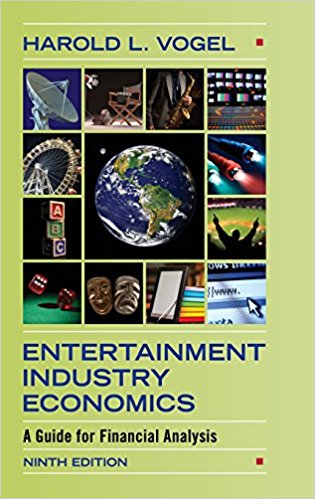 Author: Harold L. Vogel
Author: Harold L. Vogel
Publisher: Cambridge University Press – 690 pages
Book Review by: Deekay Daulat
Globally, annual spending on entertainment reached nearly one trillion dollars, and in the United States alone, it was $320 billion (with 160 billion hours spent) according to the author. We suppose these figures are for 2015, when the ninth edition of this book was published. With these many editions, which is very rare for books, this one has become a very important source of data and valuable insight into the entertainment industry.
The term ‘entertainment’ is a very broad one. What is entertainment? The author Harold Vogel writes: “at the most fundamental level, anything that stimulates, encourages, or otherwise generates a condition of pleasurable diversion could be called entertainment…but entertainment can be much more than mere diversion.”
“It is something that is universally interesting and appealing because, when it does what it is intended to do, it moves you emotionally. As the Latin root verb tenare suggests, it grabs you: It touches your soul…(because) …“it encompasses activities that people enjoy and look forward to doing, hearing or seeing.”
This ninth (2015) edition of a very popular a reference work that was first published more than thirty years ago in 1986 is a well-used source of information on the many components (see chapter titles below) of the entertainment business in the United States, and to some extent, overseas.
Not just being a work of reference, this book of nearly 700 pages is a clear, comprehensive, and up-to-date synthesis of the economics of the entertainment sector of the United States’ economy, and those of other countries, covering its accounting, economics, financing, production, and marketing, and other aspects.
This highly useful guide is being used by accountants, advertisers, economists, financial analysts, industry executives, investors, journalists, lawyers, legislators, regulators, students preparing to enter any aspect of this profession, and others to whom this sourcebook is essential in decision-making.
Fifteen chapters listed by title below and other sections comprise this essential guide for intelligent decision-making:
- Part I. Introduction
- Chapter 1. Economic Perspectives
- Chapter 2. Basic Elements
- Part II. Media-department entertainment
- Chapter 3. Movie macroeconomics
- Chapter 4. Making and marketing movies
- Chapter 5. Financial accounting in movies and television
- Chapter 6. Music
- Chapter 7. Broadcasting
- Chapter 8. Cable
- Chapter 9. Publishing
- Chapter 10. Toys and games
- Part III. Live entertainment
- Chapter 11. Gaming and wagering
- Chapter 12. Sports
- Chapter 13. Performing arts and culture
- Chapter 14. Amusement / theme parks
- Part IV. Roundup
- Chapter 15. Performance and policy
- Appendix A. Sources of information
- Appendix B. Major games of chance
- Appendix C. Supplementary data
- Glossary
- References
- Index
There is probably no other comprehensive source of information available out there except this one, on the economics of not only the entertainment industry, but also its various components.
For example, Appendix C in Table S1.1 entitled Aggregate economic statistics relating to spending on recreational goods and services, provides dollar amounts for the years spanning 1970 to 2013. It shows how much people spent on various forms of entertainment and recreation, including movies, cable, casinos, sports, theater, and others.
It is interesting to note that in 1970, when the average consumer’s disposable income was $762 and total personal consumption expenditure (PCE) was $648, he or she spent $32 on recreation, or 6.2 percent of PCE. Fast forward 33 years later to 2013: the average consumer’s disposable income had grown 16 times as much as in 1970 to $12,476, the total PCE was $11,502, and he or she spent $775 or 6.7 percent of that on recreation, or just a little higher proportion than in 1970.
These income and consumption amounts point out simply that as incomes grow, so does spending on recreational activities, including entertainment. The spending of $775 in 2013 was a whopping 24 times multiple of $32 in 1970.
Such information and much more found in this book provides an essential background in making the right decisions for anyone involved in, or dealing with the entertainment sector of the U.S. economy.
This is a must-have book on the economics of the United States’ entertainment industry.
Author:
Harold L. Vogel was senior entertainment industry analyst at Merrill Lynch & Co., Inc. for 17 years and was ranked the top analyst for this industry for ten years by Institutional Investor magazine.
Holder of a PhD in financial economics and also a chartered financial analyst (CFA), he writes and speaks frequently on investment topics related to entertainment and media, leisure and travel, and extreme markets events while leading an independent investment and consulting firm in New York City.
His books include Financial Market Bubbles and Crashes (Cambridge University Press, 2011) and Travel Industry Economics: A Guide for Financial Analysts, second edition (Cambridge University Press, 2012), a companion to this volume.







